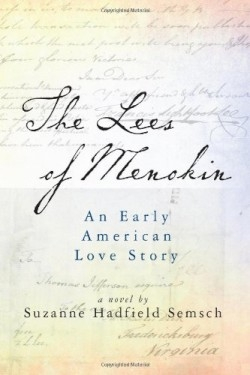The Lees of Menokin
Set in the chaotic era of the American Revolution, The Lees of Menokin focuses on the life of Francis Lightfoot Lee, a little known patriot. Lee, often portrayed as a “calm, rather inconspicuous man,” was surrounded by “that hot-headed group of radicals” in the Virginia House of Burgesses in the years leading up to the Revolution. He may have been inconspicuous, but as one of the signers of the Declaration of Independence, Lee committed treason in support of American independence. Author Suzanne Hadfield Semsch admits in her opening note to falling under the spell of Menokin, the Virginia home of Lee and his wife Rebecca Tayloe Lee, and that she “truly fell in love with Frank and his Becky.”
This quiet and unassuming novel —with a six-page bibliography that denotes years of research —avoids conflict at every turn, emphasizing Lee’s retiring personality. Yet in its tepid, timid way, the novel presents the inhumanity of slavery and the horrors of war.
The best parts of this novel are the fictional scenes and characters created by Semsch. It is these characters who illustrate the hardships and strife of the time and the inequalities that the founding fathers fostered in their own daily lives. Becky’s slave, Cate, and her son Samuel shine. And through Peter Hauck, a working-class American, the author shows the atrocities of war. From rape and pillage to starvation, deprivation, and medical care by drunken doctors who hack off limbs and leave their patients to bleed to death, the heroic Hauck experiences it all. The irony, whether it’s intended or not, is that Hauck recounts these tales to Francis Lee who listens respectfully, while he serves on the same committees that set up the hospitals, chose the military leadership, and failed to adequately clothe and feed the Continental Army. These fictionalized aspects of the novel stand head and shoulders above the painstakingly researched and biased tribute to Frank and Becky.
Semsch’s carefully controlled writing and trivial dialogue bog down what could be an exciting, well-researched tale of early American life. With a more balanced approach, more fiction to spice up a rather boring relationship between Frank and Becky, and more skillful crafting of scenes and dialogue, this would make for a fun read for the historic fiction buff.
Disclosure: This article is not an endorsement, but a review. The publisher of this book provided free copies of the book and paid a small fee to have their book reviewed by a professional reviewer. Foreword Reviews and Clarion Reviews make no guarantee that the publisher will receive a positive review. Foreword Magazine, Inc. is disclosing this in accordance with the Federal Trade Commission’s 16 CFR, Part 255.

